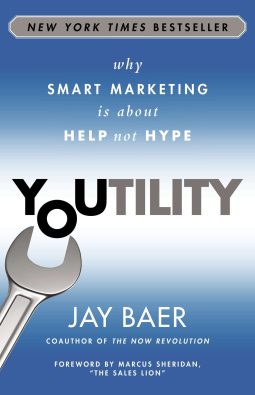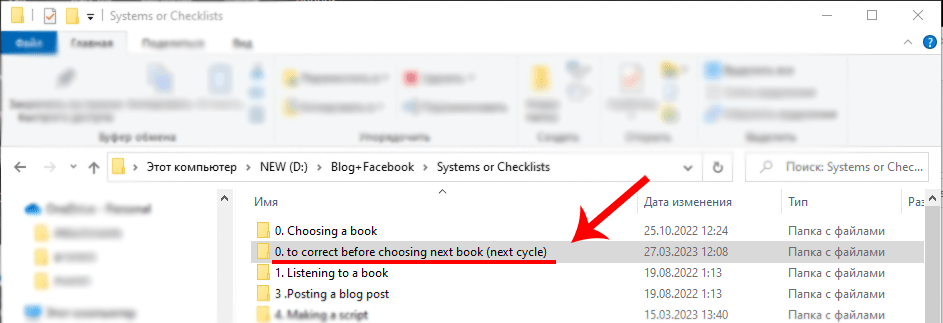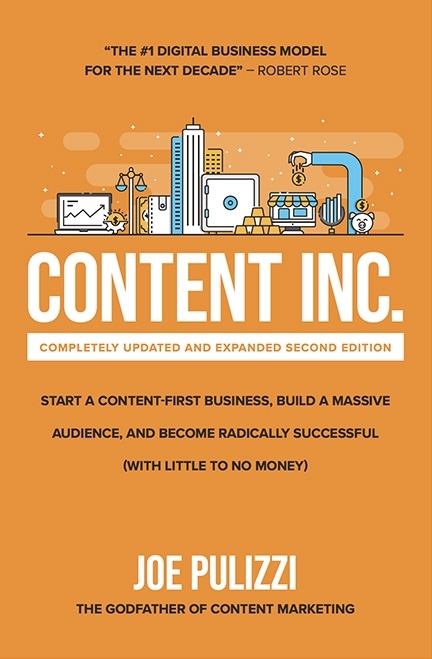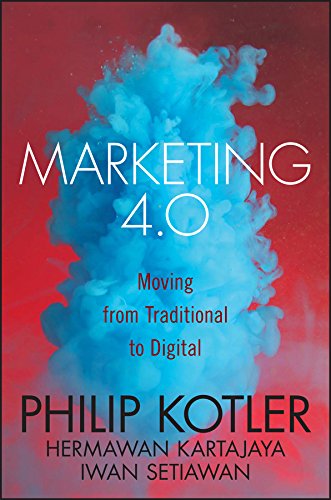A concise overview of the book that Joe Pulizzi suggests, and 3 Takeaways for Content Creators.
Let´s see what Youtility by Jay Baer has to offer.


Decision Process
A book that was suggested in the previous book I summarized – Content Inc. and I also thought I heard Nathan Berry say, he puts a *permanent asterisk* to Jay Baer’s books, but apparently he spoke about Bear Brooks(26:02) (I hope I spell right).
I also am pretty sure I heard Jay’s name mentioned in other books, and, well… I thought the book would be relevant for you – the Content Creator. I didn’t even check whether it was already covered on YouTube and Google because of what’s stated above.
Book Attributes
A tiny bit of technical data
Author
Jay Baer – Started his career in politics as a direct mail specialist for a United States senator.
Today he is a founder of 5 multi-million dollar businesses and author of 6 best-selling books about customer-acquisition to name a few of his achievements(elaborated here).
Length
Physical/Audio: 240 pages/4 hours 51 minutes
Reviews
On Amazon.com the book has 357 reviews (As of writing) 89% of which are 4 or 5 stars
Introduction
Below are each of the 12 chapters of the book and my interpretation of them (Striving to objectivity).
Part I: Turning Marketing Upside Down
There are generally three types of marketing, in this part Jay explains what they are, and what are they for.
Chapter 1: Top-of-Mind Awareness
The old “Shout as loud as you can” marketing. Tell about your services on each channel, and spread the word. Mainly self-centered. When there were a few media channels it was super effective. Today it’s the least effective marketing type. (Although still essential in some quantity.)
Chapter 2: Frame-of-Mind Awareness
This is marketing that relies on the search engines to help locate you. It relies on people already having a need and starting to research for it, at which point they find you. It is indeed important, but it is not everything.
Chapter 3: Friend-of-Mine Awareness
This type of marketing is similar to word of mouth, and in-fact, word of mouth is a part of it.
Before searching for anything on Google, people often ask for suggestions on social media.
If you participate there regularly with useful information, and not a continuous sales pitch, you may receive a status similar to that of friends, accompanied with loyalty, just as real friends. (Of course it doesn’t hurt if their friends actually recommend you 🙂 )
Part II: The Three Facets of Youtility
There are three types of actions in which Youtility shows itself or “facets”. Let’s see why, and how it’s useful.
Chapter 4: Self-Serve Information
In today’s media age, consumers often do research before contacting the company. Sometimes jumping straight to purchase without even contacting the company.
This tendency is getting stronger and stronger with time. That is why we need to supply a lot of information, so that consumers could actually learn everything they need by themselves.
Just to illustrate, some research showed that the average consumer in the U.S. engages 5 data-points before deciding where to go to eat.
Chapter 5: Radical Transparency
As highlighted in Marcus Sheridan’s They Ask, You Answer book and philosophy – Answer every single question the customer has with radical transparency. It might be so transparent, that you even tell them how much you paid for the products you’re selling them.
Eventually even if you help them solve a lot of issues for which they might have paid you for free(and you want to do that), everyone comes to a point where they feel they’re over their head, and need a professional. Where do you think they will go then?
Chapter 6: Real-Time Relevancy
Provide people the services they need in the exact location/time/season/situation they are.
For example if your niche is agriculture, you may send out a newsletter about dealing with pests that appear in the winter in the audience’s location, a little bit before they appear.
Part III: Six Blueprints to Create Youtility
The first part was about general marketing types. The second about ways that Youtility works.
The third is about how to implement Youtility.
Chapter 7: Identify Customer Needs
In order to actually identify the audience´s needs you may use various tools like
Google Trends, Google Suggest, Google Keyword Tool(Within google ads) / General analytics
or have conversations with your customers or do social listening on social media.
Chapter 8: Map Customer Needs to Useful Marketing
How is it best that your customers get your information? Through what channel(Facebook/Blog/Pinterest)?
And through what format(PDF/eBook/Event)?
Channel
It is likely there is one channel that your audience engages more than others.
Sometimes though because of different consuming habits it is best to repurpose that content for different channels (not copy).
Format
Another consideration is the format. Different formats cater to different stages in the research process(Prospect/Lead etc.). So you may want to have a few of those.
Chapter 9: Market Your Marketing
Parrallel to your traditional marketing efforts, include the marketing of your Youtility.
When you do so, don’t focus on product benefits or trying to sell. Focus on it´s providing of useful information.
This approach may not increase sales immediately, but if you gain trust, you will spend less on marketing in the long term, and if your audience needs your paid services, they will know where to find you.
Also, your employees have incredible influence, don´t forget you´re marketing to them too.
Chapter 10: Insource Youtility
Every person in your company has their own specialization and things to contribute to your Youtility effort, therefor pay attention that you include them in it!
There are 4 types of participation: Circumstancial, Voluntary, Assisted, and Mandatory Participation.
All 4 may work.
Chapter 11: Make Youtility a Process, Not a Project
Youtility is an ongoing effort because:
1. Consumer needs expand. For example in the frozen foods industry, new foods are produced at a crazy pace.
2. New technology is constantly invented, and if you want to keep up, you’ll have to integrate it.
3. You increase the chance of creating a “Great” Youtility as you persist, and create “Good” ones in the process. Which are not bad as of themselves.
Chapter 12: Keeping Score
There are two ways to justify Youtility to colleagues.
One, is by showing how many Youtility sources they themselves use before buying products.
The second, is by measuring numbers. There are generally four kinds of those: Consumption, advocacy & sharing, lead-acquisition, and sales metrics.
Then, to measure ROI in companies that have the numbers like River Pools and Spas (Customer Average Lifetime Value, Revenue, etc.) you just add them up.
In others, when you don’t see results in direct sales measure all available metrics and try to find a correlation.
If this correlation repeats itself after elaborated research, you may assume that the correlating metrics are interconnected and base your decisions on that.
3 Takeaways You May Find Useful

Focus on 1 Idea and Many Examples
Actually this is something I’ve inferred from the writing style of Jay, not a direct suggestion.
He presents each Idea and then many examples to explain it, which repeat the same essence, which actually makes the reading lighter, and you memorize the contents better.
Even though I didn’t exactly apply that in the current blogpost (Because I decided to follow the old system I had, before updating it for the next post) I will most definitely consider it for the next content piece.
Confirmed No Selling In Content Approach (Generally)
As stated in the summary of Chapter 9, Jay’s approach for Youtility is that it should first and foremost be useful. Then, the audience will find your services when they need them.
Which connect to my previous thought that reviewing books and selling them at the same time may make my reviews biased. I’d rather get e-mail subscribers because they would like to get more useful information from me, and then, if I choose to, I may promote the books I found particularly outstanding through there.
Re-Focus On Analytics
Analyze analytics results of advertisements and content in general in the beginning of each content cycle.
– Include this in written form in the beginning of the process (See images below)
Then, make conclusions from it, and adjust the according parts in the process accordingly


My General Experience Youtility

-As mentioned in the takeaways, Jay’s book is a very light read. I’ve been able to get through it smoothly with relatively few rewinds because it has lots of examples.
-I didn’t feel any “Eureka” moments, but that is probably because I have got through a bunch of marketing books already. I do suggest this book nonetheless 🙂
-The book seems to be directed both to companies/individuals who’s sole focus is content creation and to those who just have a content creation initiative as a part of a bigger product program, if it would have been just for content creators without a product yet, it would have spoken to me even better.
Analyzing Subscription Results - Content Inc.
Content Inc.’s blog post and YouTube video finished their cycle on 12.04.23
The main goal remains the same – E-mail Subscribers.
The result: 4 form visitors and 1 subscriber. (Woohoo and welcome 🙂 )
Previous: 4 form visitors and 0 subscribers.
Below is a screenshot of the CI form results.

Image 2 (Two other forms with no subs or views)
What made it different?
Looking backwards, one difference between M4.0 and CI is that in the YouTube video of m4.0 I just show my own application examples. While in CI there are exercises for the audience. Which might explain the higher viewer to like rate.
(In no way is it isolated, but maybe if I pay attention to these factors in the results of a few posts, It will show a pattern).
Raw ad numbers
3 Ads were launched, just as in M4.0 for 1 week with a budget of 23 GBP approximately.
The PPC(Search) results were: I messed something up so basically it didn’t run.
The YouTube results were: 114,458 Impressions and 2,477 Views. likes 39.
Double the views, because It accidentally ran double the time planned. It also had a higher like to view ratio, in relation to M4.0.
The Facebook results were: Reach 2,601 , Reproductions of over 3 seconds – 646. Reactions – 0 ( A lot more reach than M4.0 because of a clicks campaign goal instead of “message me” )
Analysis Conclusion
1. Make an effort to continue with the exercises in the next video to see if the better view to like ratio repeats itself , and check that the PPC ad is running a few days afterwards, so that I could also test the blog for results.
1.51 % for CI ( 2376 views to 36 likes )
1.23 % for M4.0 ( 1131 views to 14 likes )
2. Next iteration make 2 facebook ads – one which is the best performing as of now(Leads) and another to test if I may find a more performing one.
Rating (6 Parameters)
Narration
Clarity of Speech
How clear and understandable was the voice? 6/6
Fluency
Were there any gulps, voice jumps? Recording interruptions? The higher the score – the less interruptions. 5/7
There were many gulps and breaths, but they were in between sentences in a way that almost wasn´t felt.
Expressing Emotions
How much does it sound as if the narrator was really there?
How attached is he to the sentiment in the story?
And how well does he transfer the emotion to the reader? 7/7
Awesome narration by Jay, and awesome++ foreword narration by Marcus Sheridan.
Plot
Is there a storyline? How connected is one Idea to the one before it?
Answer: 10/10
Very well structured. And has a logical flow of events. Although not a fiction story, definitely not bad.
I didn’t feel there was some principle Jay was building upon that I lacked with this order of structure.
Heading Distribution
When I read the heading, can I recall the contents?
Answer: 9/10
Apart for 1 heading out of 12, all headings make the main ideas of the according chapters pop in my mind.
Drive For Implementation
How much does the book push you to apply it’s contents?
Visuals
Does it use images or other resources to transfer it’s message?
Answer: 0/6
The audiobook on audible has no PDF attached to it, and no additional resources. Though I might consider removing this metric going forward, because an audiobook is for audio, and It is often listened to while doing other things, so stopping to view something might actually interrupt the process.
Direct Calls to Action
How often does the author prompt you to apply the ideas in the book?
Answer: 3/7
The last part of the book is wholly a framework for us to apply content marketing. But I feel a more direct approach could be beneficial. Like giving exercises or concluding sentences that tell us exactly what to do and insisting on it.
Providing Actual Specific Details
Can you actually apply the Ideas in the book without additional resources?
Answer: The first two parts are for mindset and awareness, so I wouldn´t consider them for application, the third part may be applied partly, because it has examples for bigger companies too, not just solo content creators, while still other parts are difficult to apply because they´re described quite generally and would need further research or trial and error to apply. 3/7
Examples
How often are examples provided to explain a point, and how well do they portray the ideas?
Answer: Excellent examples, explaining the ideas very, very well. If I could give a 20+ here, I would. 20/20
Content
How interesting/useful was the content?
Answer: The book was most definitely interesting, and has many Ideas for inspiration. I wouldn’t say it’s a direct step by step guide though. 17/20
Final Rating

Narration – 18/20
Plot – 10/10
Heading Distribution – 9/10
Drive for Implementation – 6/20
Examples – 20/20
Content – 17/20
Final Rating – 80/100
Acquiring Options (Non-partner)
"This is Youtility, and, quite simply, companies that practice it are followed, subscribed to, bookmarked, and kept on the home screen of mobile devices. Companies that don’t . . . aren’t."
Freebies/PDFs
Related Articles

3 Content Inc. Ideas To Apply In Your Content
Finally a book that is just specifically for content creators (Starting without a product). !Disclaimer – The hyperlink of ConvertKit used in the post is

Marketing 4.0 – 3 True Applications for Content Marketers
Are you desperate for information you could actually finally apply? As a content creator myself I have extracted for you 3 concepts that can be

Claude Hopkins Scientific Advertising Wisdom for Content Creators
Here are 7 useful advertising principles to help you improve your content from the fundamental advertising book of Claude Hopkins – Scientific Advertising. (1923) which is recommended by the






